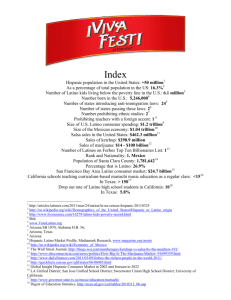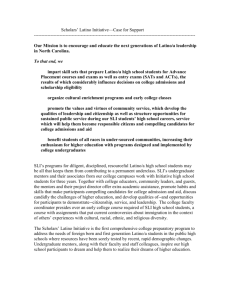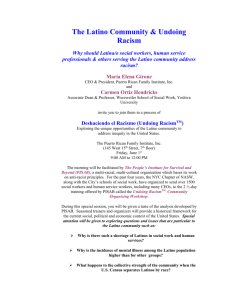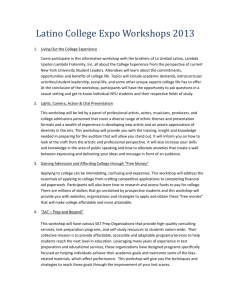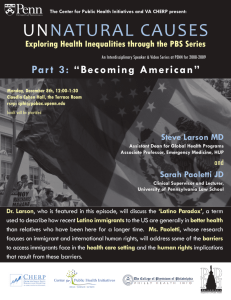ALVIN BALDUS, ET. AL Plaintiffs, TAMMY BALDWIN, GWENDOLYNNE MOORE,
advertisement
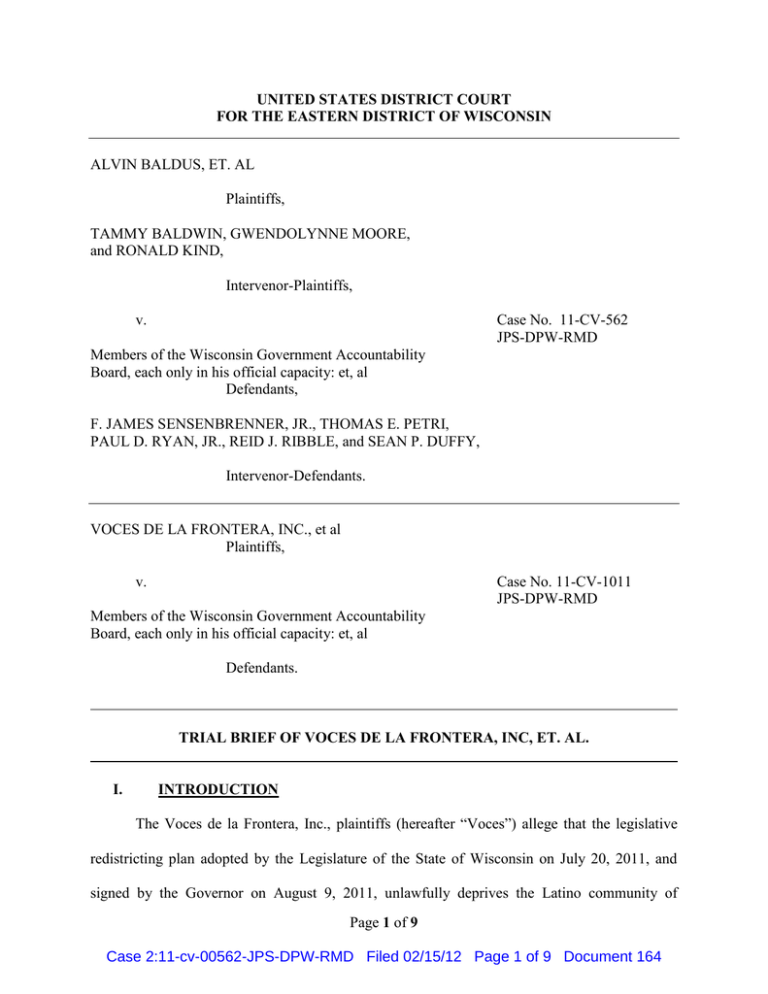
UNITED STATES DISTRICT COURT FOR THE EASTERN DISTRICT OF WISCONSIN ALVIN BALDUS, ET. AL Plaintiffs, TAMMY BALDWIN, GWENDOLYNNE MOORE, and RONALD KIND, Intervenor-Plaintiffs, v. Case No. 11-CV-562 JPS-DPW-RMD Members of the Wisconsin Government Accountability Board, each only in his official capacity: et, al Defendants, F. JAMES SENSENBRENNER, JR., THOMAS E. PETRI, PAUL D. RYAN, JR., REID J. RIBBLE, and SEAN P. DUFFY, Intervenor-Defendants. VOCES DE LA FRONTERA, INC., et al Plaintiffs, v. Case No. 11-CV-1011 JPS-DPW-RMD Members of the Wisconsin Government Accountability Board, each only in his official capacity: et, al Defendants. TRIAL BRIEF OF VOCES DE LA FRONTERA, INC, ET. AL. I. INTRODUCTION The Voces de la Frontera, Inc., plaintiffs (hereafter “Voces”) allege that the legislative redistricting plan adopted by the Legislature of the State of Wisconsin on July 20, 2011, and signed by the Governor on August 9, 2011, unlawfully deprives the Latino community of Page 1 of 9 Case 2:11-cv-00562-JPS-DPW-RMD Filed 02/15/12 Page 1 of 9 Document 164 Milwaukee’s near south side of an effective voting majority in any of the newly created assembly districts despite the fact that the Latino community is sufficiently numerous and geographically compact to allow for at least one assembly district with an effective voting majority. Furthermore, Voces alleges that the legislative redistricting plan fractured the Latino community by dividing it in two down the middle of its main business district and then appended to the 55% portion of the predecessor district that was retained in the newly created 8th Assembly District a significant portion of a different community area known as Wilson Park which has a far lower percentage of Latino citizens of voting age and far higher concentration of non-Latino voting age citizens. The neighborhoods in the Wilson Park area represent an entirely different and distinct community of interest and the non-Latino voting age near majority in that area have significantly higher rates of voter turnout and voter registration than do the areas with a majority of Latino eligible voters. It is undisputed that the Latino community on the near south side of Milwaukee is sufficiently numerous to form a majority of eligible voters within a geographically compact area that has a clear sense of neighborhood identity. Furthermore, all experts who considered the matter agree that the Latino community has over time demonstrated political and electoral cohesiveness. Nevertheless, the newly reapportioned 8thAssembly district fractures that community into two parts, decreases the percentage of eligible Latino voters and increases the percentage of non-Latino voters who have an empirically demonstrable degree of racially polarized voting and significantly higher voter turnout and registration percentages. Under the totality of these circumstances, it is clear that Act 43 has significantly reduced the opportunity of Milwaukee’s Latino citizens to participate in the political process on an equal basis and to elect candidates of their choice to the Legislature of Wisconsin. Page 2 of 9 Case 2:11-cv-00562-JPS-DPW-RMD Filed 02/15/12 Page 2 of 9 Document 164 II. THREE PRONGED GINGLES ASSEMBLY DISTRICTS STANDARD APPLIED TO LATINO The parties agree that this case is governed by the well established standards defined in Thornburg v. Gingles, 478 U.S. 30, 50-51 (1986), as applied to single member districts by Growe v. Emison, 507 U.S. 25, 40-41 (1993). Accordingly, before the Court can consider the totality of the circumstances, Voces must first prove that it meets the following three preconditions under §2 of the Voting Rights Act: 1). That the Latino community is sufficiently large and geographically compact to constitute a majority in a single member district; 2). That the Latino community is politically cohesive; and 3). That, in the absence of special circumstances, the White majority votes sufficiently as a bloc to enable it usually defeat the Latino community’s preferred candidate. As applied to this case, proof of the three Gingles prongs is required in order to show that the Latino community has the potential to elect a representative of its own choice, and that the challenged redistricting plan thwarts that potential by diluting the Latino community’s vote. Id. The Defendants concede that Voces has satisfied the necessary showing with regard to the first Gingles prong and the parties have stipulated to the following proposed conclusion of law: Within the meaning of the first prong of Thornburg v. Gingles, 478 U.S. 30, 48-51 (1986), the Latino community is sufficiently large and geographically compact enough to permit the creation of an assembly district with a majority of eligible Latino in the vicinity of the 8th Assembly District. Final Pretrial Report ¶241. Although the Defendants declined to stipulate to prong two, it is notable that two of the Defendants’ own experts agree that the Latino community is remarkably politically cohesive. Page 3 of 9 Case 2:11-cv-00562-JPS-DPW-RMD Filed 02/15/12 Page 3 of 9 Document 164 Dr. Bernard Grofman testified that the political and electoral conduct of Latino voters in the predecessor 8th Assembly District was in fact politically cohesive. Grofman Deposition at p. 165:5 to 165:19. Similarly, but even more emphatically, Dr. Keith Gaddie testified as follows: Q: Okay. Paragraph 23, "Over the course of the last decade, the political and electoral conduct of Latino voters on Milwaukee's near south side in the vicinity of the recently reapportioned 8th and 9th Assembly Districts demonstrates that the Latino community is politically cohesive." Do you agree with that statement? A: I generally agree with that statement. Q: In fact, you wrote a note that's on your thumb drive that says you think that the Latino community is remarkably politically cohesive? A: That's correct. Gaddie Deposition, at p. 90:9 to 90:20 The significant dispute between the parties centers on prong three. Only the Plaintiffs’ expert performed an empirical analysis according to accepted analytical standards to determine whether past electoral conduct indicates the presence of racially polarized voting. Dr. Mayer analyzed several races in which Latino candidates ran against White candidates and found a remarkably high degree of racially polarized voting. Ex. 55 at p 19-20, Report of Dr. Ken Mayer. For example in the 2011 primary for Milwaukee County Circuit Court Judge, the former elected representative of the 8th Assembly District, Pedro Colon, ran against multiple White candidates. Dr. Mayer found that 58.2% of Latinos voted for Judge Colon while only 32% of the White voters voted for him. Tr. Ex. 55, at pp. 19-20, and Ex. 7. In the general election that followed similar levels of racially polarized bloc voting were found. Id. Dr. Mayer also found a remarkable degree of racially polarized bloc voting in the 2008 general election for State Superintendent of Public Education where Spanish-surnamed Rose Fernandez ran against Tony Page 4 of 9 Case 2:11-cv-00562-JPS-DPW-RMD Filed 02/15/12 Page 4 of 9 Document 164 Evers. In that race 95.7% of the Latino voters in Milwaukee County voted for Ms. Fernandez while only 40.5% of the White voters voted for her. Id. Dr. Mayer believes that the statistical finding in support of racially polarized bloc voting is strengthened by the fact that while Spanishsurnamed, Ms. Fernandez is not in fact a Latina. He reasons this is so because it shows that voter beliefs about a candidate’s ethnicity were more important than the actuality of that ethnicity. Id., at p. 20, fn 7. As noted by Dr. Mayer, “[t]his is about as pure a test of racially polarized voting as can be created.” Id. It is notable that the Defendants’ expert, Dr. Grofman’s major criticism of Dr. Mayer’s racially polarized bloc voting analysis was summed up by the following testimony: Q: A: Q: A: Q: A: You would agree that your major criticism of Dr. Mayer's analysis of racially polarized voting in the Latino community in Milwaukee was that he didn't use what you called the best evidence, correct? Yes. Because he looked at races that were larger in their dimensions than the electoral races in the target area, correct? Yes. That's correct. So what Dr. Mayer then did was -- after he read your report was he said Okay. I'll check with the available races. And these I guess are still exogenous races, but they focus on electoral conduct in those specific areas, correct? Yes. Grofman Deposition, at p. 185:18 to p. 186:8. In other words, Dr. Grofman believes that the “best evidence” of racially polarized bloc voting is electoral data from the electoral districts in question. Id., at p. 69:1 to 69:11. Upon receipt of Dr. Grofman’s rebuttal report setting forth that criticism, Dr. Mayer undertook to analyze races reflecting electoral conduct in wards located within the predecessor districts in question in order to determine whether Dr. Grofman’s “best evidence” criticism changed the results. See Exhibits 134; 1025; Mayer Deposition, at p. 210:6 to 214:5. Dr. Mayer will testify at trial that the second round of racially polarized bloc voting analysis confirmed the accuracy of his first analysis. Page 5 of 9 Case 2:11-cv-00562-JPS-DPW-RMD Filed 02/15/12 Page 5 of 9 Document 164 III. TOTALITY OF THE CIRCUMSTANCES As demonstrated above, the Plaintiffs have satisfied the three Gingles preconditions and are permitted to demonstrate to the Court that under the totality of the circumstances, Latino citizens have less opportunity than other members of the electorate to participate in the political process and to elect candidates of their choice to the Legislature of Wisconsin. This part of the inquiry requires a “searching practical evaluation of the past and present reality.” Gingles, 478 U.S., at 45. Here, the past and present realities present two very different pictures. With regard to the “past reality,” on census day 2010, the 8th Assembly District was populated by a majority of eligible Latino voters, that had successfully elected Latino state representatives, albeit unopposed and with very low voter turnouts. With regard to the “present reality,” a politically cohesive community has been fractured geographically, diluted politically and the civil rights clock has been set back by as much as eight years. The basic demographic facts establishing this before and after contrast are not disputed. The predecessor 8th Assembly District effectively encompassed the near south side Latino community such that most persons living in the district, whether Latino or not, considered themselves to be residents of that community. Anticipated testimony of Hon. Pedro Colon, Christine Neumann-Oritiz and John Bartkowski. In other words the 8th Assembly District as drawn in 2002, accurately reflected the community of interest constituted by the near south side Latino community. The fabric of the entire community was included- the main business district, the parishes, the schools, the social service agencies, the cultural institutions, etc. Id. By the time of the 2010 census, that community had grown to the point that Latino citizens represented 52.41% of the voting age population and 69.7% of the total population in district as drawn in 2002. See Ex. 60, Dr. Mayer Rebuttal Report, at p. 8. Page 6 of 9 Case 2:11-cv-00562-JPS-DPW-RMD Filed 02/15/12 Page 6 of 9 Document 164 Based on the April 2010 census, the ideal re-apportioned population for each of the State’s assembly districts is now 57,444 persons. Accordingly, in order to achieve the required population adjustment, 2,828 persons needed to be added to the predecessor 8th Assembly District. See Table 32, Final Pretrial Report, Exhibit A. The Defendants’ expert, Dr. Bernard Grofman, testified during his deposition that the required number of additional persons could have been added to the 8th Assembly District in a way maintained the majority threshold eligible Latino voters. Grofman Deposition, at p. 184:4 to p. 185:2. However, rather than maintain that majority, Act 43 instead divided the community along Cesar Chavez Drive retaining only 55% of the Latino community and added 25,590 persons from a completely different geographic community which includes large parts of the neighborhood known as Wilson Park. Id.; Final Pretrial Report, ¶ 308. The newly added 45% of the new 8th Assembly District is approximately 41 % non-Latino and does not share a sense of identity with the Latino community. Anticipated testimony of Christine Neumann Ortiz and John Bartkowski, Dr. Mayer. Id.; This contrasts with the percentage of Whites in the retained portion of the District which is 28%. Anticipated testimony of Dr. Mayer. Accordingly, the predecessor 8th Assembly District was a very different electoral district than is the new version created by Act 43. Drawing inferences from the past electoral performance of unopposed Latino legislative candidates from the predecessor 8th Assembly District and imputing that electoral success to the new district under Act 43 pursuant to the rubric of the “totality of the circumstances” is analogous to comparing apples to oranges. An electoral district that once had a 52.41% majority of eligible Latino voters has been reduced to a district with a minority of eligible Latino voters of between 47.07% and 49.62%. Final Pretrial Report, ¶ 317; Ex. 60, Dr. Mayer Rebuttal Report, at p. 8. Most dramatically, that reduction of the Page 7 of 9 Case 2:11-cv-00562-JPS-DPW-RMD Filed 02/15/12 Page 7 of 9 Document 164 percentage of eligible Latino voters has been accompanied by an importation of a significant number of White voters from a different geographic neighborhood that has a history of much higher voter turnout and higher voter registration ratios. The 25,590 persons who were added to the 8th Assembly District also come from a neighborhood where the effects of past discrimination in areas such as education, employments, and health are less burdensome than that experienced by Latinos from the retained areas of the predecessor 8th Assembly District. Anticipated testimony of Hon. Pedro Colon, Christine Neumann-Ortiz, and John Bartkowski. The foregoing circumstances must also be considered in conjunction with the ominous findings of Dr. Peter Morrison, one of the Defendants’ expert witnesses. Dr. Morrison asserts that Act 43 has reduced the number of Latino eligible voters to only 40.9% of the population of the 8th Assembly District. Ex. 32, Table 2, Ex. 32. Based on his projections of population growth, Dr. Morrison opines that Latinos will not again achieve a majority of the eligible voters in the 8th Assembly District until November of 2018. Id., at Table 3. Although, the Plaintiffs do not credit the accuracy of the manner by which Dr. Morison calculated citizenship rates for the Latino community, his expert report does serve to underscore the degree to which the Latino community has been set back by Act 43. In other words, the reduction in the percentage of Latino eligible voters which has resulted in the loss of an effective voting majority is so severe that it will also result in a significant delay in the recuperation of that voting majority. Page 8 of 9 Case 2:11-cv-00562-JPS-DPW-RMD Filed 02/15/12 Page 8 of 9 Document 164 IV. CONCLUSION For the reasons stated above and in the Complaint, and the supporting evidence that will be preented at trial, the Consolidated Plaintiffs, Voces de la Frontera, Inc., Ramiro Vara, Olga Vara, Jose Perez, and Erica Ramirez respectfully request that this Court enjoin the implementation of Act 43 in any future election or primary. Dated at Milwaukee, Wisconsin, this 15 day of February, 2012. THE LAW OFFICE OF PETER EARLE Attorneys for the Plaintiffs /s/ By:___________________________ Peter Guyon Earle WI SBN 1012176 Address: 839 North Jefferson Street Suite 300 Milwaukee, WI 53202 (414) 276-1076 peter@earle-law.com THE LAW OFFICE OF JACQUELINE BOYNTON Attorneys for the Plaintiffs /s/ By:___________________________ Jacqueline E. Boynton WI SBN 1014570 Address: 2266 North Prospect Ave Suite 505 Milwaukee, WI 53202 (414) 276-1066 jackie@jboynton.com Page 9 of 9 Case 2:11-cv-00562-JPS-DPW-RMD Filed 02/15/12 Page 9 of 9 Document 164



